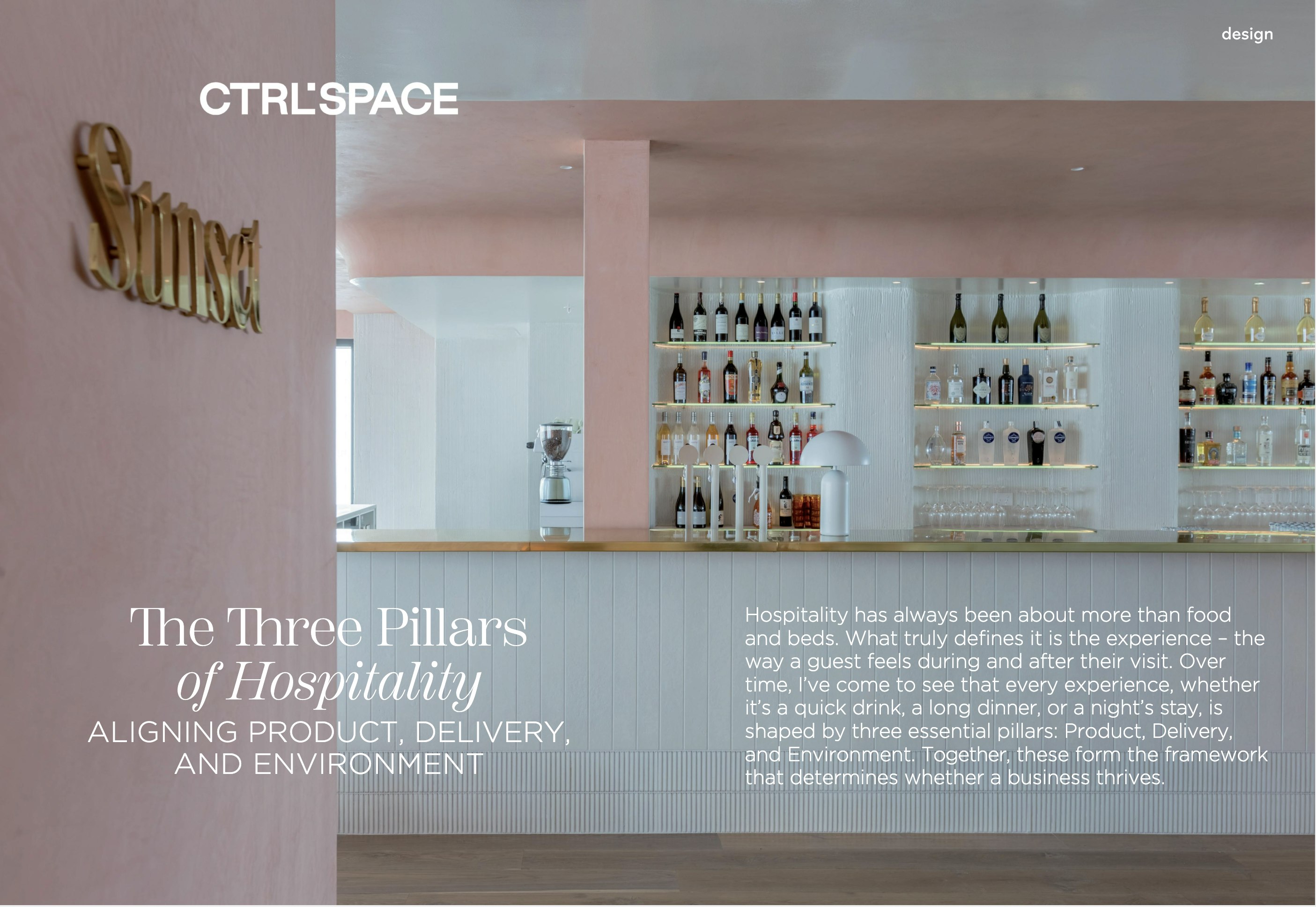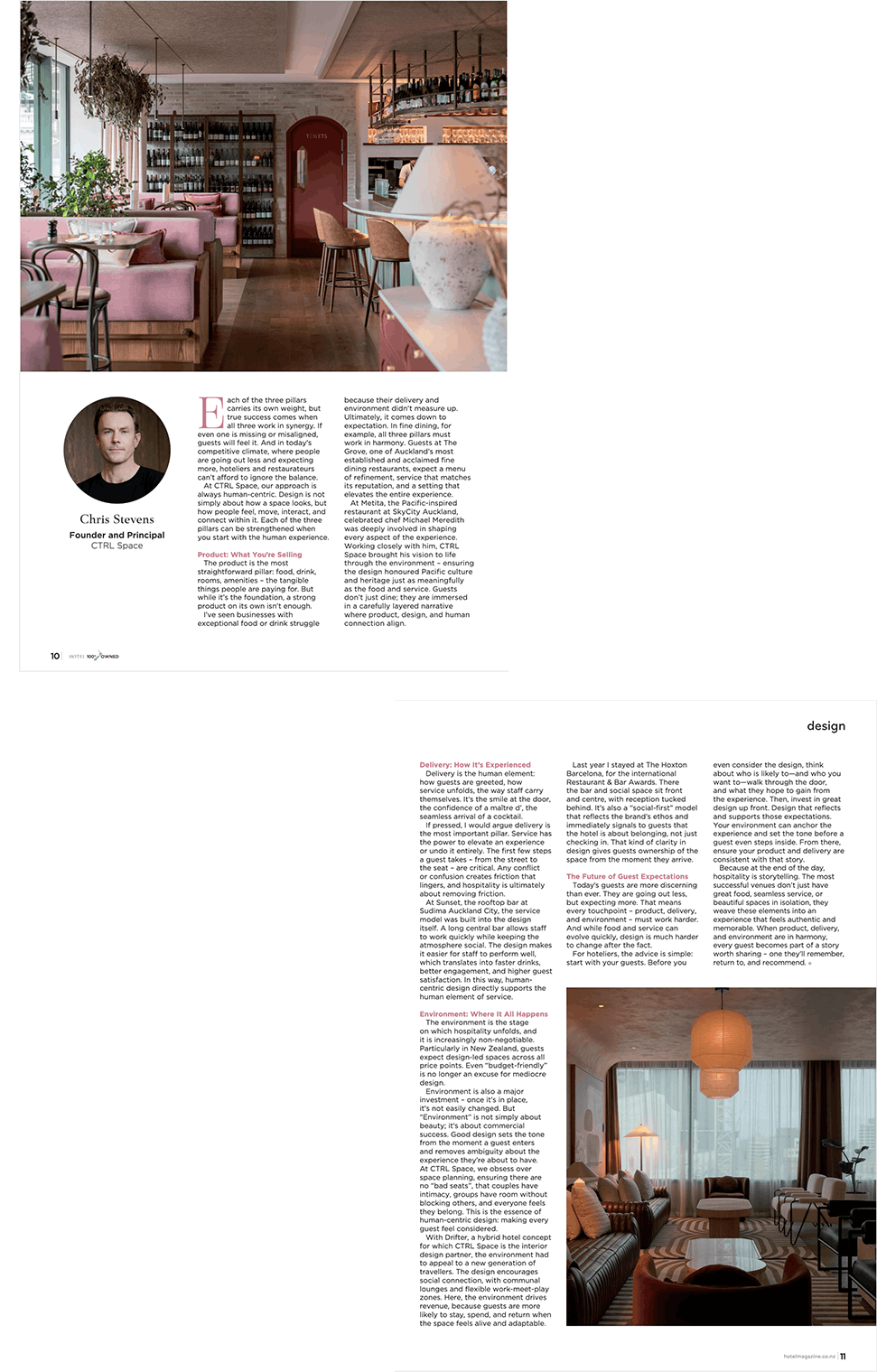At CTRL Space, our approach is always human-centric. Design is not simply about how a space looks, but how people feel, interact, and connect with it. Each of the three pillars come to life when and where you start with the human experience.
Product: What You’re Selling
The product is the most straightforward pillar – food, drink, rooms, amenities – the tangible things people pay you for. But while it’s easy to think a strong product is enough, we’ve worked with exceptional hospitality brands that struggle because their delivery and environment didn’t measure up.
Ultimately, it comes down to expectation. In fine dining, for example, all three pillars must work in harmony. Guests at The Grove, one of Auckland’s most established and acclaimed fine dining restaurants, expect a menu of refinement, service that matches its reputation, and a setting that elevates the entire experience.
At Metita, the Pacific-inspired restaurant at SkyCity Auckland, celebrated Michael Meredith was deeply involved in shaping every aspect of the experience. Working closely with him, CTRL Space brought this vision to life through environment – ensuring the design honoured Pacific culture and heritage as a source of pride and as a lived guest experience. But don’t just dine; they are immersed through food, layered narrative, considered design, and human connection alike.
Delivery: How It’s Experienced
Delivery is the human element: how guests are greeted, how service unfolds, the way staff carry themselves. It’s the smile at the door, the confidence of a maître d’, the seamless arrival of a cocktail.
If pressed, I would argue delivery is the most important pillar. Service has the power to elevate an experience or undo it entirely. The first few steps a guest takes – from the street to the seat – are critical. Any conflict or confusion creates friction that lingers, and hospitality is ultimately about removing friction.
At Sunset, the rooftop bar at Sudima Auckland City, the service model was built into the design itself. A long central bar allows staff to work quickly while keeping the atmosphere social. The design makes it easier for staff to perform well, which translates into faster drinks, better engagement, and higher guest satisfaction. In this way, human-centric design directly supports the human element of service.
Environment: Where It All Happens
The environment is the stage on which hospitality unfolds, and it is increasingly non-negotiable. Particularly in New Zealand, guests expect design-led spaces across all price points. Even “budget-friendly” is no longer an excuse for mediocre design.
Environment is also a major investment – once it’s in place, it’s not easily changed. But “environment” is not simply about beauty; it’s about commercial success. Good design sets the tone for mood, moments and memories, and it determines whether guests are excited by or ambivalent about a venue.
At CTRL Space, we obsess over space planning, because there are no “bad seats,” that couples have intimacy, groups have room without blocking others, and everyone feels they belong. This is the essence of human-centred design: making every design feel considered, and making every guest feel invited.
With Drifter, a hybrid hotel concept for which CTRL Space is the interior design partner, the environment had to appeal to an entirely cross-cultural of travellers. The design encourages social connection with communal lounges, flexible live-work-meet-play zones. Here, the environment drives response because guests are more likely to stay, spend, and return when the space feels alive and adaptable.
The Future of Guest Expectations
Today’s guests are more discerning than ever. They are not coming for your backstory, but expecting more. That means every touchpoint – product, delivery and environment – must be clear and cohesive. Guest expectations evolve quickly, design is much harder to change after the fact.
For hoteliers, the advice is simple: start with your guests. Before you even consider the design, think about who is likely to – and who you want to – walk through the door, and what they hope to gain from the experience. Then invest in great design up front. Design that reflects and supports those expectations.
Your environment can anchor the experience, your service defines it, and your product must do the work to ensure your guests return. Done well, hospitality isn’t about the most beautiful spaces in isolation, it weaves these elements into an experience that is emotional, memorable and generous.
When product, delivery, and environment are in harmony, every guest becomes part of a story worth sharing – one they’ll remember, return to, and recommend.

